Comparative Analysis of Soft Power Strategies: China and India
VerifiedAdded on 2023/06/10
|8
|2474
|250
Essay
AI Summary
This essay undertakes a comparative analysis of the soft power strategies employed by China and India, focusing on how these nations leverage their media and cultural assets to exert influence on the global stage. The essay delves into the motivations behind these initiatives, examining the concrete measures undertaken by both countries, the global responses they elicit, and the ultimate impacts of their soft power endeavors. It highlights the similarities and differences in their approaches, such as the role of Bollywood in India and the Chinese film industry's efforts, and their respective success in promoting cultural values and traditions. The analysis also considers the influence of the United States on both nations' media landscapes and critically evaluates their soft power initiatives by referencing relevant concepts and theories, including the impact of democratic values versus authoritarian control, and the role of cultural exchange and international communication.
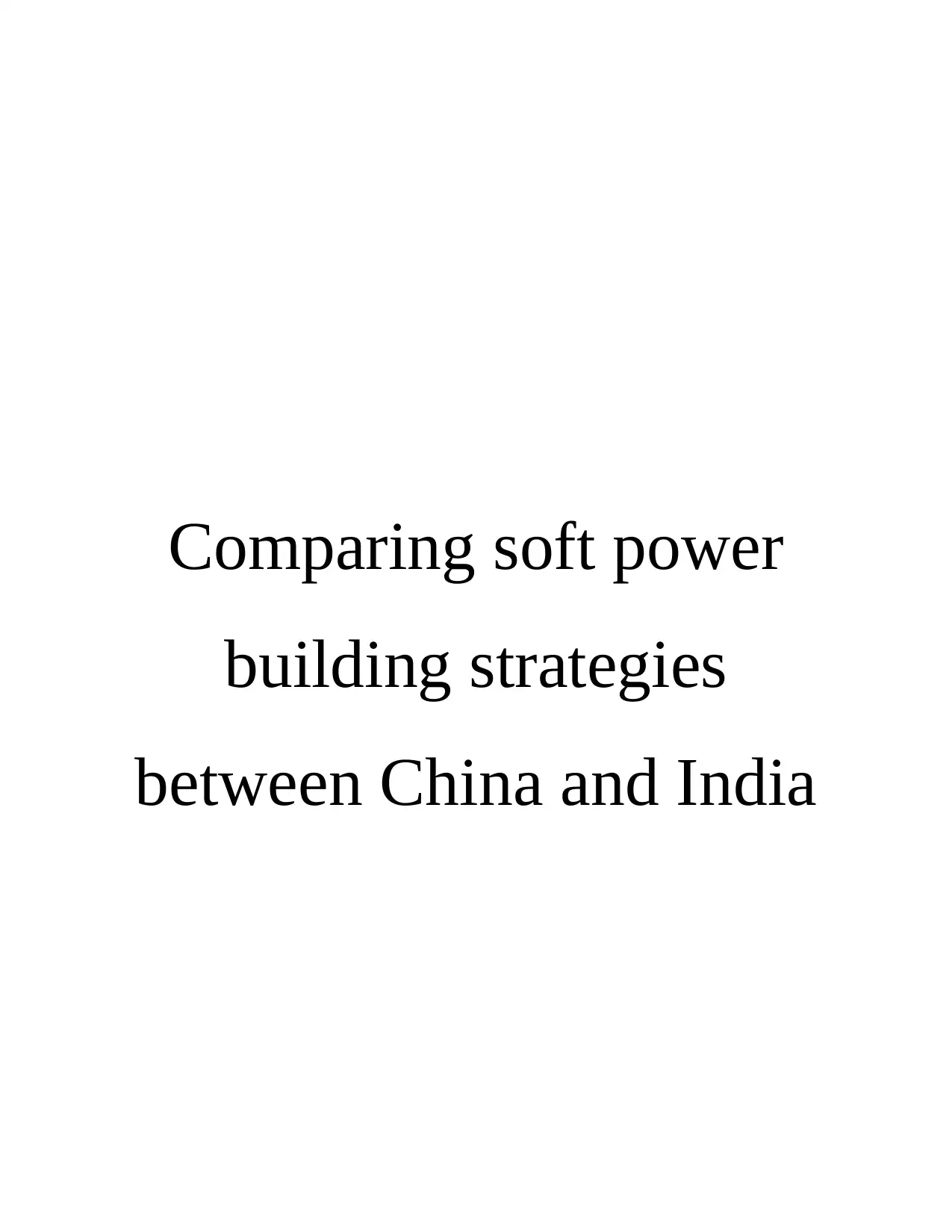
Comparing soft power
building strategies
between China and India
building strategies
between China and India
Paraphrase This Document
Need a fresh take? Get an instant paraphrase of this document with our AI Paraphraser
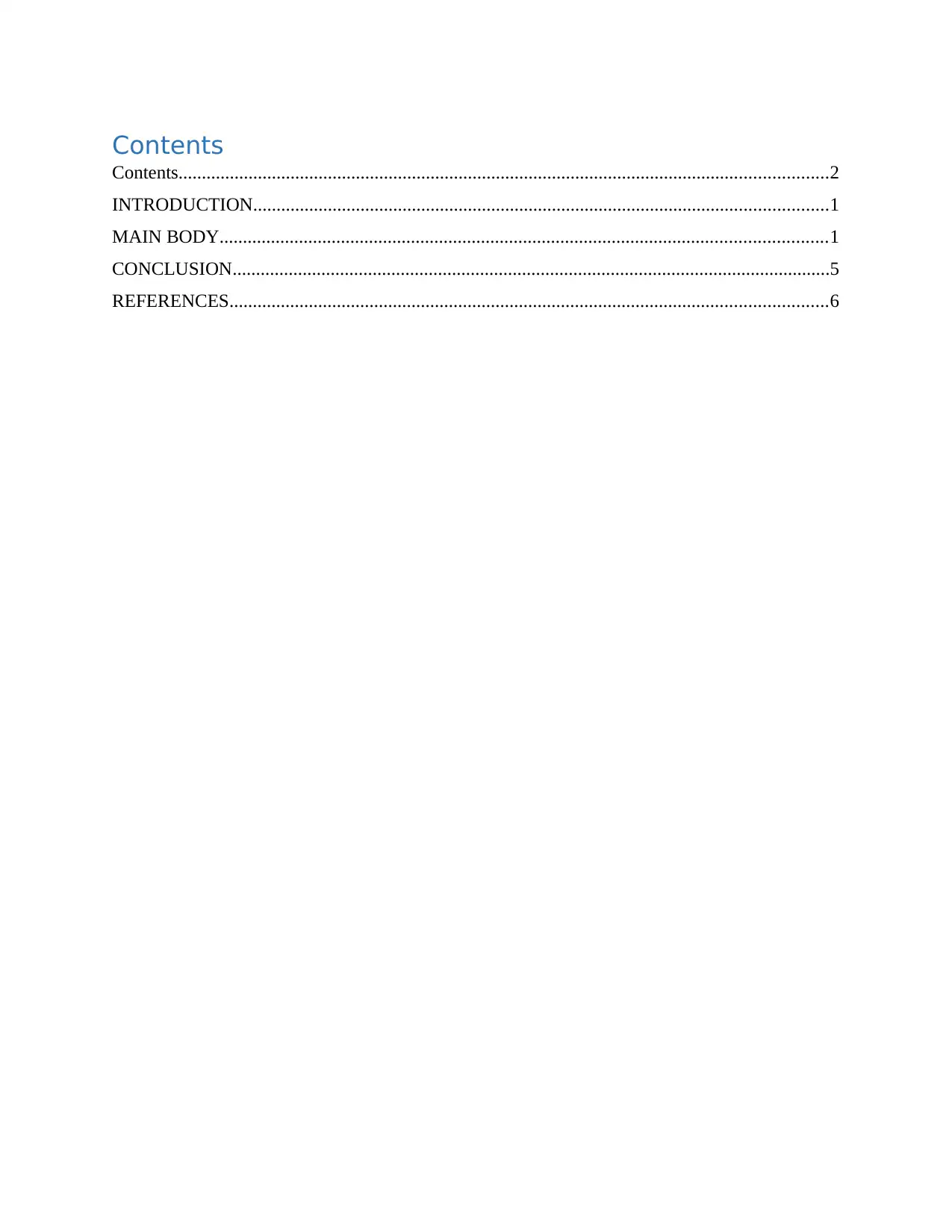
Contents
Contents...........................................................................................................................................2
INTRODUCTION...........................................................................................................................1
MAIN BODY..................................................................................................................................1
CONCLUSION................................................................................................................................5
REFERENCES................................................................................................................................6
Contents...........................................................................................................................................2
INTRODUCTION...........................................................................................................................1
MAIN BODY..................................................................................................................................1
CONCLUSION................................................................................................................................5
REFERENCES................................................................................................................................6
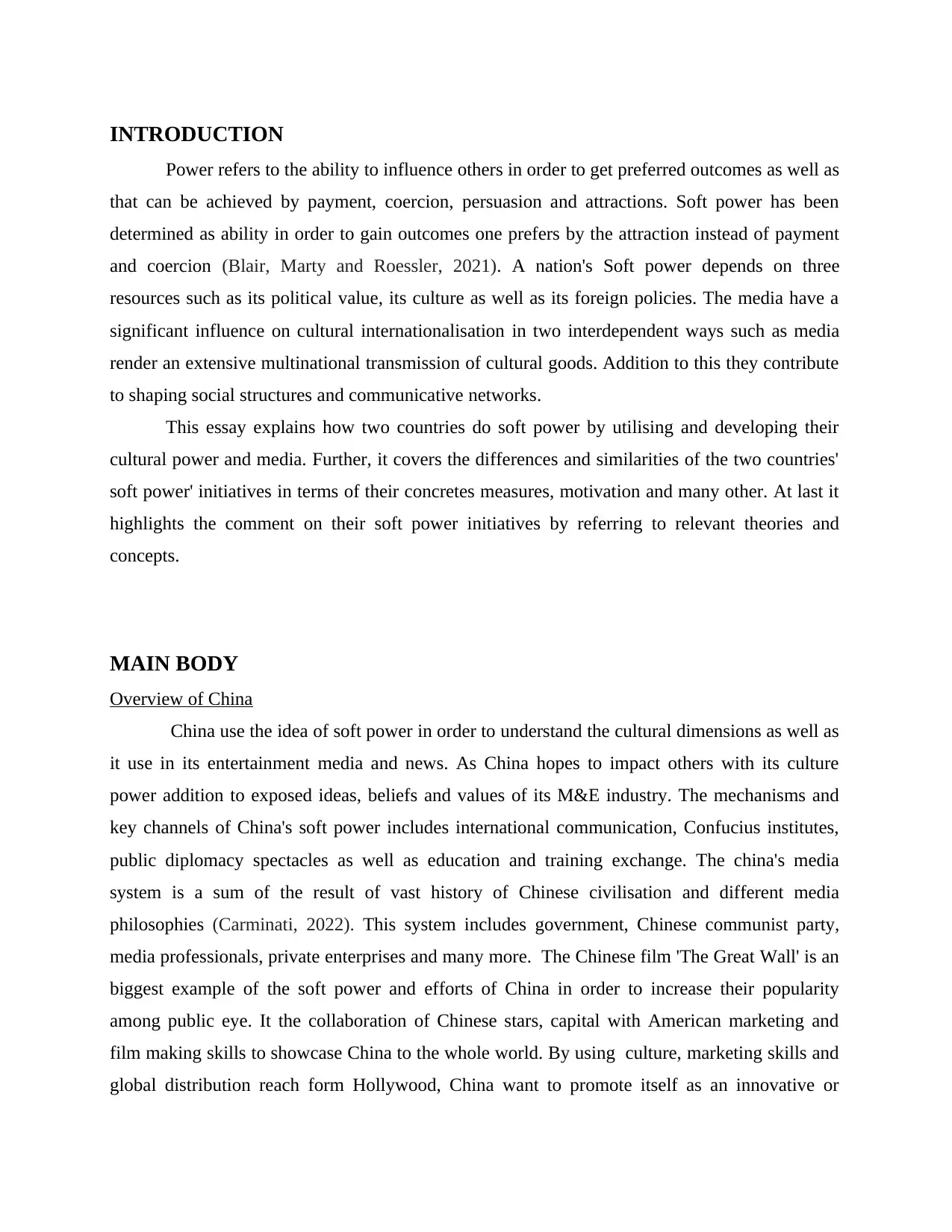
INTRODUCTION
Power refers to the ability to influence others in order to get preferred outcomes as well as
that can be achieved by payment, coercion, persuasion and attractions. Soft power has been
determined as ability in order to gain outcomes one prefers by the attraction instead of payment
and coercion (Blair, Marty and Roessler, 2021). A nation's Soft power depends on three
resources such as its political value, its culture as well as its foreign policies. The media have a
significant influence on cultural internationalisation in two interdependent ways such as media
render an extensive multinational transmission of cultural goods. Addition to this they contribute
to shaping social structures and communicative networks.
This essay explains how two countries do soft power by utilising and developing their
cultural power and media. Further, it covers the differences and similarities of the two countries'
soft power' initiatives in terms of their concretes measures, motivation and many other. At last it
highlights the comment on their soft power initiatives by referring to relevant theories and
concepts.
MAIN BODY
Overview of China
China use the idea of soft power in order to understand the cultural dimensions as well as
it use in its entertainment media and news. As China hopes to impact others with its culture
power addition to exposed ideas, beliefs and values of its M&E industry. The mechanisms and
key channels of China's soft power includes international communication, Confucius institutes,
public diplomacy spectacles as well as education and training exchange. The china's media
system is a sum of the result of vast history of Chinese civilisation and different media
philosophies (Carminati, 2022). This system includes government, Chinese communist party,
media professionals, private enterprises and many more. The Chinese film 'The Great Wall' is an
biggest example of the soft power and efforts of China in order to increase their popularity
among public eye. It the collaboration of Chinese stars, capital with American marketing and
film making skills to showcase China to the whole world. By using culture, marketing skills and
global distribution reach form Hollywood, China want to promote itself as an innovative or
Power refers to the ability to influence others in order to get preferred outcomes as well as
that can be achieved by payment, coercion, persuasion and attractions. Soft power has been
determined as ability in order to gain outcomes one prefers by the attraction instead of payment
and coercion (Blair, Marty and Roessler, 2021). A nation's Soft power depends on three
resources such as its political value, its culture as well as its foreign policies. The media have a
significant influence on cultural internationalisation in two interdependent ways such as media
render an extensive multinational transmission of cultural goods. Addition to this they contribute
to shaping social structures and communicative networks.
This essay explains how two countries do soft power by utilising and developing their
cultural power and media. Further, it covers the differences and similarities of the two countries'
soft power' initiatives in terms of their concretes measures, motivation and many other. At last it
highlights the comment on their soft power initiatives by referring to relevant theories and
concepts.
MAIN BODY
Overview of China
China use the idea of soft power in order to understand the cultural dimensions as well as
it use in its entertainment media and news. As China hopes to impact others with its culture
power addition to exposed ideas, beliefs and values of its M&E industry. The mechanisms and
key channels of China's soft power includes international communication, Confucius institutes,
public diplomacy spectacles as well as education and training exchange. The china's media
system is a sum of the result of vast history of Chinese civilisation and different media
philosophies (Carminati, 2022). This system includes government, Chinese communist party,
media professionals, private enterprises and many more. The Chinese film 'The Great Wall' is an
biggest example of the soft power and efforts of China in order to increase their popularity
among public eye. It the collaboration of Chinese stars, capital with American marketing and
film making skills to showcase China to the whole world. By using culture, marketing skills and
global distribution reach form Hollywood, China want to promote itself as an innovative or
⊘ This is a preview!⊘
Do you want full access?
Subscribe today to unlock all pages.

Trusted by 1+ million students worldwide
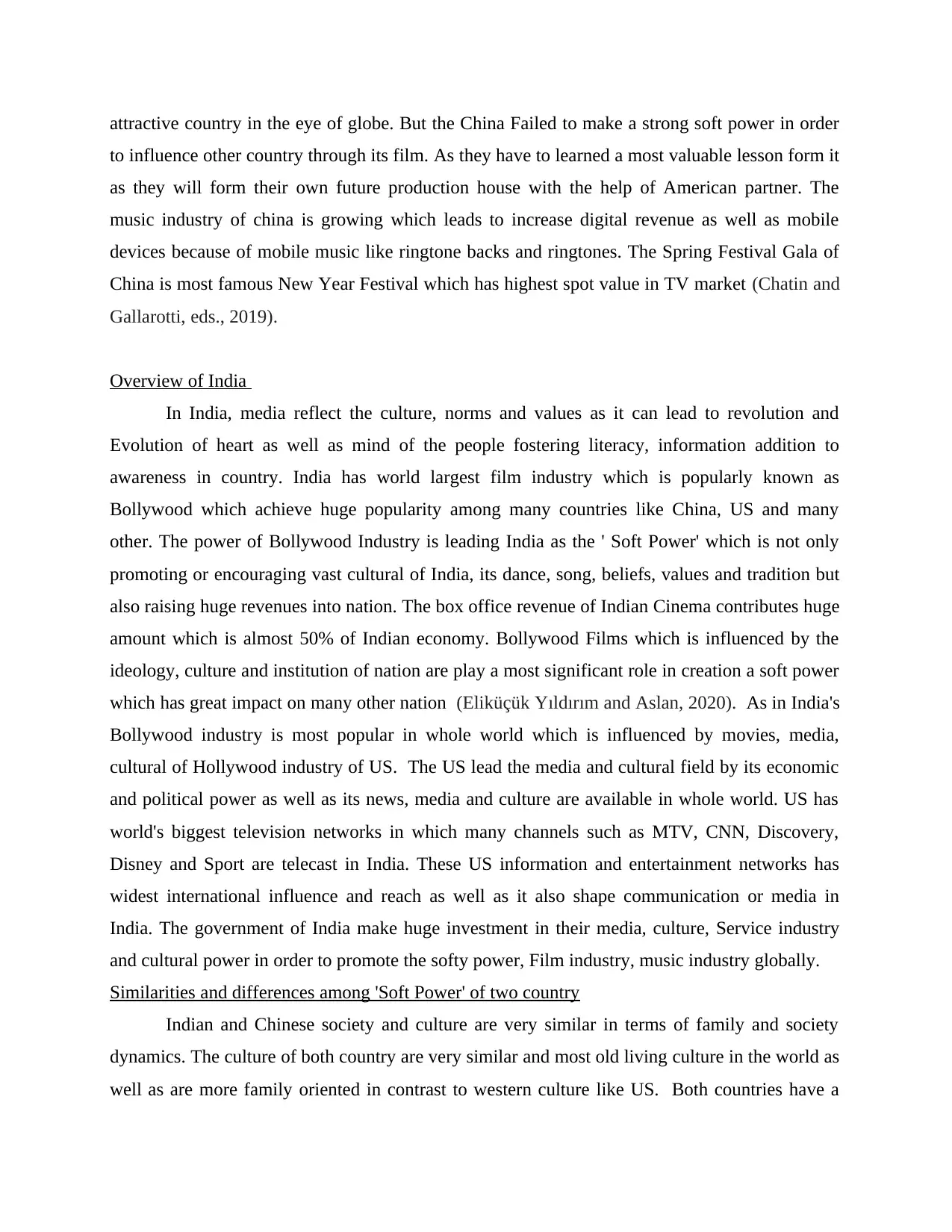
attractive country in the eye of globe. But the China Failed to make a strong soft power in order
to influence other country through its film. As they have to learned a most valuable lesson form it
as they will form their own future production house with the help of American partner. The
music industry of china is growing which leads to increase digital revenue as well as mobile
devices because of mobile music like ringtone backs and ringtones. The Spring Festival Gala of
China is most famous New Year Festival which has highest spot value in TV market (Chatin and
Gallarotti, eds., 2019).
Overview of India
In India, media reflect the culture, norms and values as it can lead to revolution and
Evolution of heart as well as mind of the people fostering literacy, information addition to
awareness in country. India has world largest film industry which is popularly known as
Bollywood which achieve huge popularity among many countries like China, US and many
other. The power of Bollywood Industry is leading India as the ' Soft Power' which is not only
promoting or encouraging vast cultural of India, its dance, song, beliefs, values and tradition but
also raising huge revenues into nation. The box office revenue of Indian Cinema contributes huge
amount which is almost 50% of Indian economy. Bollywood Films which is influenced by the
ideology, culture and institution of nation are play a most significant role in creation a soft power
which has great impact on many other nation (Eliküçük Yıldırım and Aslan, 2020). As in India's
Bollywood industry is most popular in whole world which is influenced by movies, media,
cultural of Hollywood industry of US. The US lead the media and cultural field by its economic
and political power as well as its news, media and culture are available in whole world. US has
world's biggest television networks in which many channels such as MTV, CNN, Discovery,
Disney and Sport are telecast in India. These US information and entertainment networks has
widest international influence and reach as well as it also shape communication or media in
India. The government of India make huge investment in their media, culture, Service industry
and cultural power in order to promote the softy power, Film industry, music industry globally.
Similarities and differences among 'Soft Power' of two country
Indian and Chinese society and culture are very similar in terms of family and society
dynamics. The culture of both country are very similar and most old living culture in the world as
well as are more family oriented in contrast to western culture like US. Both countries have a
to influence other country through its film. As they have to learned a most valuable lesson form it
as they will form their own future production house with the help of American partner. The
music industry of china is growing which leads to increase digital revenue as well as mobile
devices because of mobile music like ringtone backs and ringtones. The Spring Festival Gala of
China is most famous New Year Festival which has highest spot value in TV market (Chatin and
Gallarotti, eds., 2019).
Overview of India
In India, media reflect the culture, norms and values as it can lead to revolution and
Evolution of heart as well as mind of the people fostering literacy, information addition to
awareness in country. India has world largest film industry which is popularly known as
Bollywood which achieve huge popularity among many countries like China, US and many
other. The power of Bollywood Industry is leading India as the ' Soft Power' which is not only
promoting or encouraging vast cultural of India, its dance, song, beliefs, values and tradition but
also raising huge revenues into nation. The box office revenue of Indian Cinema contributes huge
amount which is almost 50% of Indian economy. Bollywood Films which is influenced by the
ideology, culture and institution of nation are play a most significant role in creation a soft power
which has great impact on many other nation (Eliküçük Yıldırım and Aslan, 2020). As in India's
Bollywood industry is most popular in whole world which is influenced by movies, media,
cultural of Hollywood industry of US. The US lead the media and cultural field by its economic
and political power as well as its news, media and culture are available in whole world. US has
world's biggest television networks in which many channels such as MTV, CNN, Discovery,
Disney and Sport are telecast in India. These US information and entertainment networks has
widest international influence and reach as well as it also shape communication or media in
India. The government of India make huge investment in their media, culture, Service industry
and cultural power in order to promote the softy power, Film industry, music industry globally.
Similarities and differences among 'Soft Power' of two country
Indian and Chinese society and culture are very similar in terms of family and society
dynamics. The culture of both country are very similar and most old living culture in the world as
well as are more family oriented in contrast to western culture like US. Both countries have a
Paraphrase This Document
Need a fresh take? Get an instant paraphrase of this document with our AI Paraphraser
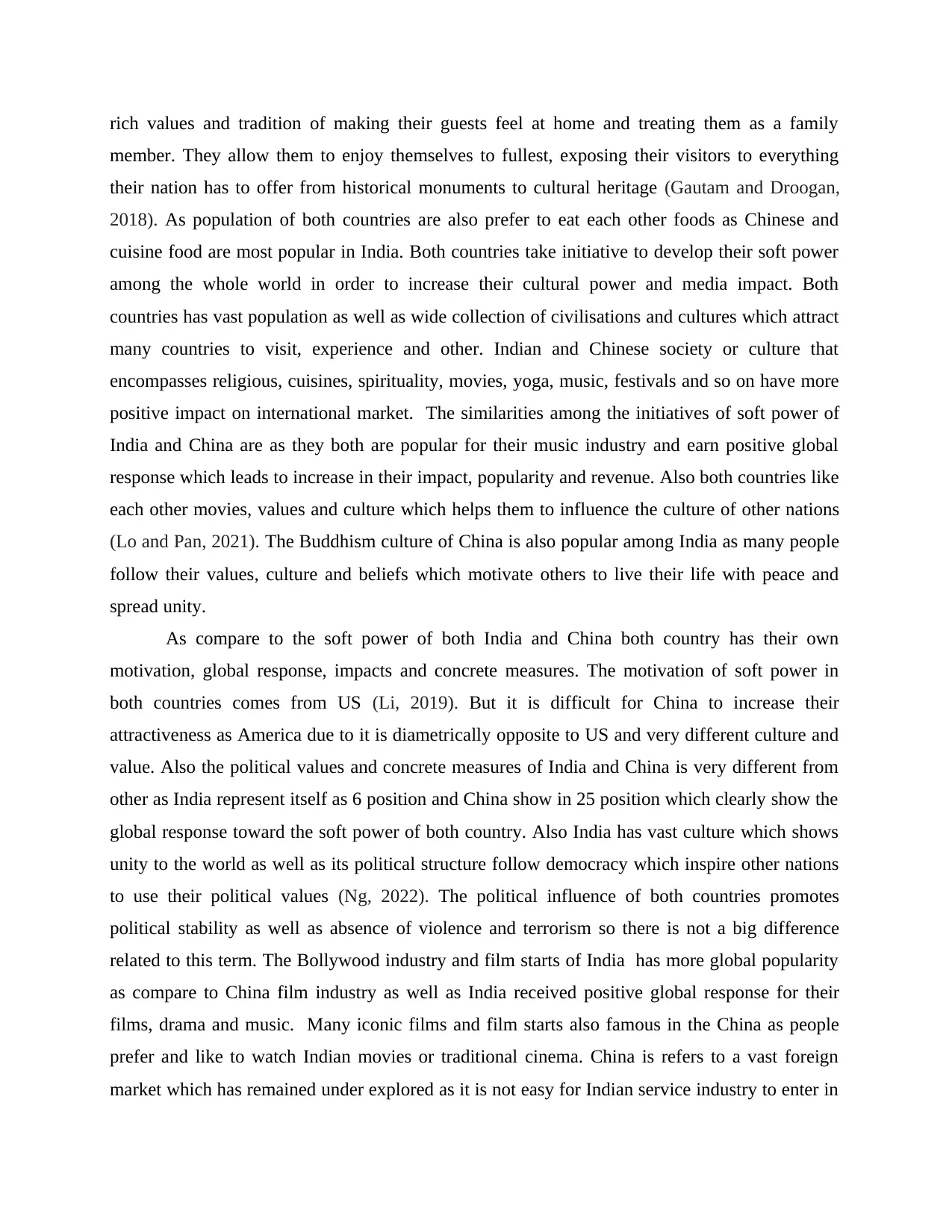
rich values and tradition of making their guests feel at home and treating them as a family
member. They allow them to enjoy themselves to fullest, exposing their visitors to everything
their nation has to offer from historical monuments to cultural heritage (Gautam and Droogan,
2018). As population of both countries are also prefer to eat each other foods as Chinese and
cuisine food are most popular in India. Both countries take initiative to develop their soft power
among the whole world in order to increase their cultural power and media impact. Both
countries has vast population as well as wide collection of civilisations and cultures which attract
many countries to visit, experience and other. Indian and Chinese society or culture that
encompasses religious, cuisines, spirituality, movies, yoga, music, festivals and so on have more
positive impact on international market. The similarities among the initiatives of soft power of
India and China are as they both are popular for their music industry and earn positive global
response which leads to increase in their impact, popularity and revenue. Also both countries like
each other movies, values and culture which helps them to influence the culture of other nations
(Lo and Pan, 2021). The Buddhism culture of China is also popular among India as many people
follow their values, culture and beliefs which motivate others to live their life with peace and
spread unity.
As compare to the soft power of both India and China both country has their own
motivation, global response, impacts and concrete measures. The motivation of soft power in
both countries comes from US (Li, 2019). But it is difficult for China to increase their
attractiveness as America due to it is diametrically opposite to US and very different culture and
value. Also the political values and concrete measures of India and China is very different from
other as India represent itself as 6 position and China show in 25 position which clearly show the
global response toward the soft power of both country. Also India has vast culture which shows
unity to the world as well as its political structure follow democracy which inspire other nations
to use their political values (Ng, 2022). The political influence of both countries promotes
political stability as well as absence of violence and terrorism so there is not a big difference
related to this term. The Bollywood industry and film starts of India has more global popularity
as compare to China film industry as well as India received positive global response for their
films, drama and music. Many iconic films and film starts also famous in the China as people
prefer and like to watch Indian movies or traditional cinema. China is refers to a vast foreign
market which has remained under explored as it is not easy for Indian service industry to enter in
member. They allow them to enjoy themselves to fullest, exposing their visitors to everything
their nation has to offer from historical monuments to cultural heritage (Gautam and Droogan,
2018). As population of both countries are also prefer to eat each other foods as Chinese and
cuisine food are most popular in India. Both countries take initiative to develop their soft power
among the whole world in order to increase their cultural power and media impact. Both
countries has vast population as well as wide collection of civilisations and cultures which attract
many countries to visit, experience and other. Indian and Chinese society or culture that
encompasses religious, cuisines, spirituality, movies, yoga, music, festivals and so on have more
positive impact on international market. The similarities among the initiatives of soft power of
India and China are as they both are popular for their music industry and earn positive global
response which leads to increase in their impact, popularity and revenue. Also both countries like
each other movies, values and culture which helps them to influence the culture of other nations
(Lo and Pan, 2021). The Buddhism culture of China is also popular among India as many people
follow their values, culture and beliefs which motivate others to live their life with peace and
spread unity.
As compare to the soft power of both India and China both country has their own
motivation, global response, impacts and concrete measures. The motivation of soft power in
both countries comes from US (Li, 2019). But it is difficult for China to increase their
attractiveness as America due to it is diametrically opposite to US and very different culture and
value. Also the political values and concrete measures of India and China is very different from
other as India represent itself as 6 position and China show in 25 position which clearly show the
global response toward the soft power of both country. Also India has vast culture which shows
unity to the world as well as its political structure follow democracy which inspire other nations
to use their political values (Ng, 2022). The political influence of both countries promotes
political stability as well as absence of violence and terrorism so there is not a big difference
related to this term. The Bollywood industry and film starts of India has more global popularity
as compare to China film industry as well as India received positive global response for their
films, drama and music. Many iconic films and film starts also famous in the China as people
prefer and like to watch Indian movies or traditional cinema. China is refers to a vast foreign
market which has remained under explored as it is not easy for Indian service industry to enter in
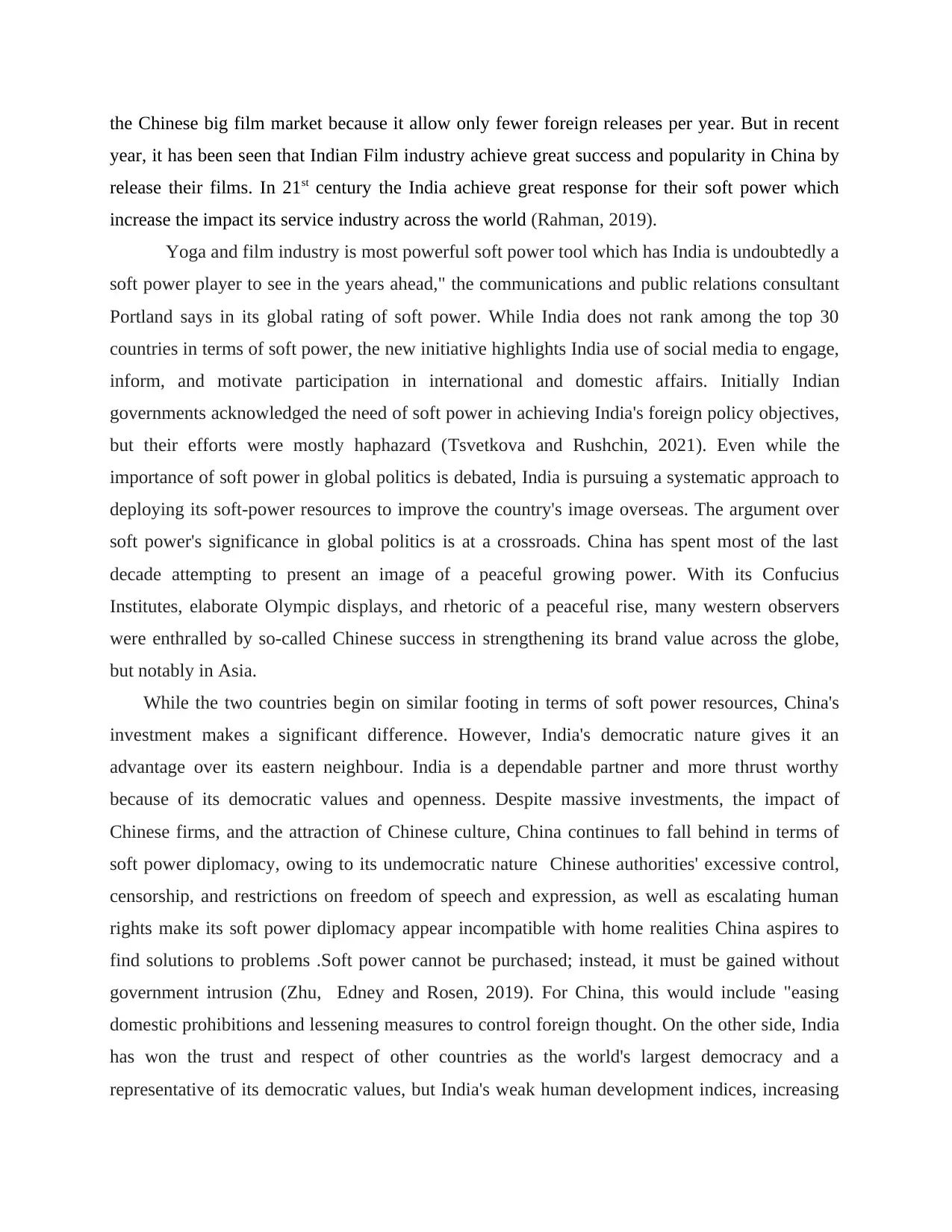
the Chinese big film market because it allow only fewer foreign releases per year. But in recent
year, it has been seen that Indian Film industry achieve great success and popularity in China by
release their films. In 21st century the India achieve great response for their soft power which
increase the impact its service industry across the world (Rahman, 2019).
Yoga and film industry is most powerful soft power tool which has India is undoubtedly a
soft power player to see in the years ahead," the communications and public relations consultant
Portland says in its global rating of soft power. While India does not rank among the top 30
countries in terms of soft power, the new initiative highlights India use of social media to engage,
inform, and motivate participation in international and domestic affairs. Initially Indian
governments acknowledged the need of soft power in achieving India's foreign policy objectives,
but their efforts were mostly haphazard (Tsvetkova and Rushchin, 2021). Even while the
importance of soft power in global politics is debated, India is pursuing a systematic approach to
deploying its soft-power resources to improve the country's image overseas. The argument over
soft power's significance in global politics is at a crossroads. China has spent most of the last
decade attempting to present an image of a peaceful growing power. With its Confucius
Institutes, elaborate Olympic displays, and rhetoric of a peaceful rise, many western observers
were enthralled by so-called Chinese success in strengthening its brand value across the globe,
but notably in Asia.
While the two countries begin on similar footing in terms of soft power resources, China's
investment makes a significant difference. However, India's democratic nature gives it an
advantage over its eastern neighbour. India is a dependable partner and more thrust worthy
because of its democratic values and openness. Despite massive investments, the impact of
Chinese firms, and the attraction of Chinese culture, China continues to fall behind in terms of
soft power diplomacy, owing to its undemocratic nature Chinese authorities' excessive control,
censorship, and restrictions on freedom of speech and expression, as well as escalating human
rights make its soft power diplomacy appear incompatible with home realities China aspires to
find solutions to problems .Soft power cannot be purchased; instead, it must be gained without
government intrusion (Zhu, Edney and Rosen, 2019). For China, this would include "easing
domestic prohibitions and lessening measures to control foreign thought. On the other side, India
has won the trust and respect of other countries as the world's largest democracy and a
representative of its democratic values, but India's weak human development indices, increasing
year, it has been seen that Indian Film industry achieve great success and popularity in China by
release their films. In 21st century the India achieve great response for their soft power which
increase the impact its service industry across the world (Rahman, 2019).
Yoga and film industry is most powerful soft power tool which has India is undoubtedly a
soft power player to see in the years ahead," the communications and public relations consultant
Portland says in its global rating of soft power. While India does not rank among the top 30
countries in terms of soft power, the new initiative highlights India use of social media to engage,
inform, and motivate participation in international and domestic affairs. Initially Indian
governments acknowledged the need of soft power in achieving India's foreign policy objectives,
but their efforts were mostly haphazard (Tsvetkova and Rushchin, 2021). Even while the
importance of soft power in global politics is debated, India is pursuing a systematic approach to
deploying its soft-power resources to improve the country's image overseas. The argument over
soft power's significance in global politics is at a crossroads. China has spent most of the last
decade attempting to present an image of a peaceful growing power. With its Confucius
Institutes, elaborate Olympic displays, and rhetoric of a peaceful rise, many western observers
were enthralled by so-called Chinese success in strengthening its brand value across the globe,
but notably in Asia.
While the two countries begin on similar footing in terms of soft power resources, China's
investment makes a significant difference. However, India's democratic nature gives it an
advantage over its eastern neighbour. India is a dependable partner and more thrust worthy
because of its democratic values and openness. Despite massive investments, the impact of
Chinese firms, and the attraction of Chinese culture, China continues to fall behind in terms of
soft power diplomacy, owing to its undemocratic nature Chinese authorities' excessive control,
censorship, and restrictions on freedom of speech and expression, as well as escalating human
rights make its soft power diplomacy appear incompatible with home realities China aspires to
find solutions to problems .Soft power cannot be purchased; instead, it must be gained without
government intrusion (Zhu, Edney and Rosen, 2019). For China, this would include "easing
domestic prohibitions and lessening measures to control foreign thought. On the other side, India
has won the trust and respect of other countries as the world's largest democracy and a
representative of its democratic values, but India's weak human development indices, increasing
⊘ This is a preview!⊘
Do you want full access?
Subscribe today to unlock all pages.

Trusted by 1+ million students worldwide
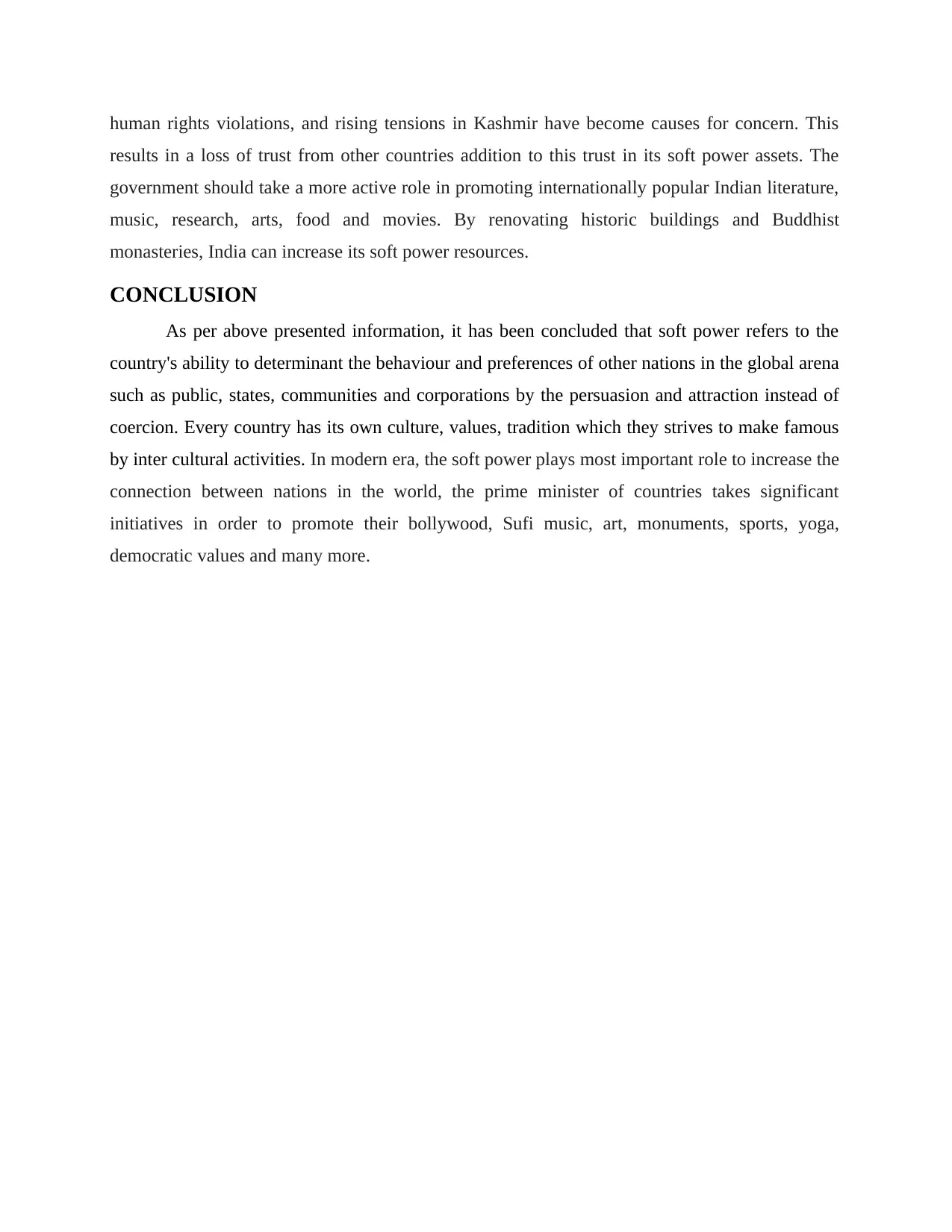
human rights violations, and rising tensions in Kashmir have become causes for concern. This
results in a loss of trust from other countries addition to this trust in its soft power assets. The
government should take a more active role in promoting internationally popular Indian literature,
music, research, arts, food and movies. By renovating historic buildings and Buddhist
monasteries, India can increase its soft power resources.
CONCLUSION
As per above presented information, it has been concluded that soft power refers to the
country's ability to determinant the behaviour and preferences of other nations in the global arena
such as public, states, communities and corporations by the persuasion and attraction instead of
coercion. Every country has its own culture, values, tradition which they strives to make famous
by inter cultural activities. In modern era, the soft power plays most important role to increase the
connection between nations in the world, the prime minister of countries takes significant
initiatives in order to promote their bollywood, Sufi music, art, monuments, sports, yoga,
democratic values and many more.
results in a loss of trust from other countries addition to this trust in its soft power assets. The
government should take a more active role in promoting internationally popular Indian literature,
music, research, arts, food and movies. By renovating historic buildings and Buddhist
monasteries, India can increase its soft power resources.
CONCLUSION
As per above presented information, it has been concluded that soft power refers to the
country's ability to determinant the behaviour and preferences of other nations in the global arena
such as public, states, communities and corporations by the persuasion and attraction instead of
coercion. Every country has its own culture, values, tradition which they strives to make famous
by inter cultural activities. In modern era, the soft power plays most important role to increase the
connection between nations in the world, the prime minister of countries takes significant
initiatives in order to promote their bollywood, Sufi music, art, monuments, sports, yoga,
democratic values and many more.
Paraphrase This Document
Need a fresh take? Get an instant paraphrase of this document with our AI Paraphraser
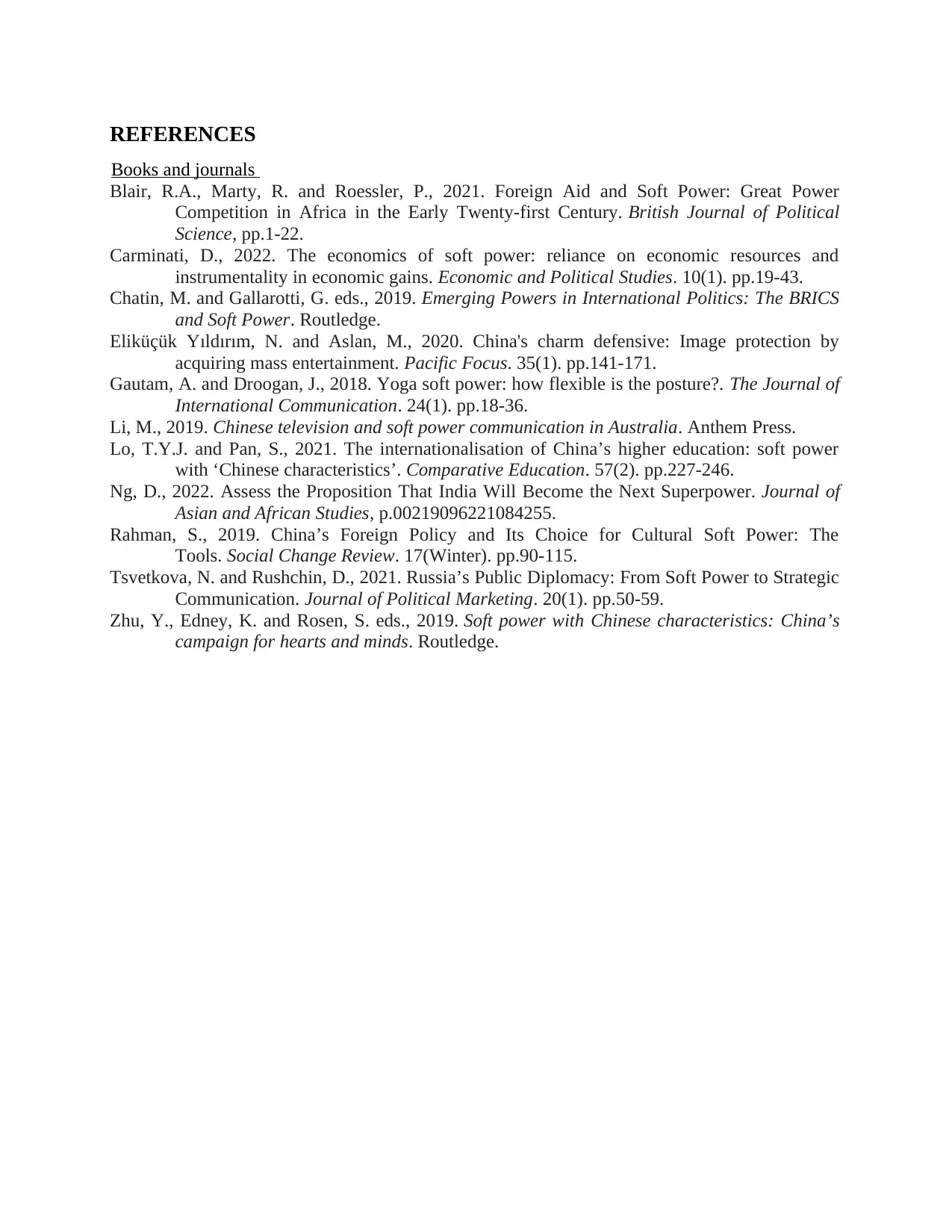
REFERENCES
Books and journals
Blair, R.A., Marty, R. and Roessler, P., 2021. Foreign Aid and Soft Power: Great Power
Competition in Africa in the Early Twenty-first Century. British Journal of Political
Science, pp.1-22.
Carminati, D., 2022. The economics of soft power: reliance on economic resources and
instrumentality in economic gains. Economic and Political Studies. 10(1). pp.19-43.
Chatin, M. and Gallarotti, G. eds., 2019. Emerging Powers in International Politics: The BRICS
and Soft Power. Routledge.
Eliküçük Yıldırım, N. and Aslan, M., 2020. China's charm defensive: Image protection by
acquiring mass entertainment. Pacific Focus. 35(1). pp.141-171.
Gautam, A. and Droogan, J., 2018. Yoga soft power: how flexible is the posture?. The Journal of
International Communication. 24(1). pp.18-36.
Li, M., 2019. Chinese television and soft power communication in Australia. Anthem Press.
Lo, T.Y.J. and Pan, S., 2021. The internationalisation of China’s higher education: soft power
with ‘Chinese characteristics’. Comparative Education. 57(2). pp.227-246.
Ng, D., 2022. Assess the Proposition That India Will Become the Next Superpower. Journal of
Asian and African Studies, p.00219096221084255.
Rahman, S., 2019. China’s Foreign Policy and Its Choice for Cultural Soft Power: The
Tools. Social Change Review. 17(Winter). pp.90-115.
Tsvetkova, N. and Rushchin, D., 2021. Russia’s Public Diplomacy: From Soft Power to Strategic
Communication. Journal of Political Marketing. 20(1). pp.50-59.
Zhu, Y., Edney, K. and Rosen, S. eds., 2019. Soft power with Chinese characteristics: China’s
campaign for hearts and minds. Routledge.
Books and journals
Blair, R.A., Marty, R. and Roessler, P., 2021. Foreign Aid and Soft Power: Great Power
Competition in Africa in the Early Twenty-first Century. British Journal of Political
Science, pp.1-22.
Carminati, D., 2022. The economics of soft power: reliance on economic resources and
instrumentality in economic gains. Economic and Political Studies. 10(1). pp.19-43.
Chatin, M. and Gallarotti, G. eds., 2019. Emerging Powers in International Politics: The BRICS
and Soft Power. Routledge.
Eliküçük Yıldırım, N. and Aslan, M., 2020. China's charm defensive: Image protection by
acquiring mass entertainment. Pacific Focus. 35(1). pp.141-171.
Gautam, A. and Droogan, J., 2018. Yoga soft power: how flexible is the posture?. The Journal of
International Communication. 24(1). pp.18-36.
Li, M., 2019. Chinese television and soft power communication in Australia. Anthem Press.
Lo, T.Y.J. and Pan, S., 2021. The internationalisation of China’s higher education: soft power
with ‘Chinese characteristics’. Comparative Education. 57(2). pp.227-246.
Ng, D., 2022. Assess the Proposition That India Will Become the Next Superpower. Journal of
Asian and African Studies, p.00219096221084255.
Rahman, S., 2019. China’s Foreign Policy and Its Choice for Cultural Soft Power: The
Tools. Social Change Review. 17(Winter). pp.90-115.
Tsvetkova, N. and Rushchin, D., 2021. Russia’s Public Diplomacy: From Soft Power to Strategic
Communication. Journal of Political Marketing. 20(1). pp.50-59.
Zhu, Y., Edney, K. and Rosen, S. eds., 2019. Soft power with Chinese characteristics: China’s
campaign for hearts and minds. Routledge.
1 out of 8
Related Documents
Your All-in-One AI-Powered Toolkit for Academic Success.
+13062052269
info@desklib.com
Available 24*7 on WhatsApp / Email
![[object Object]](/_next/static/media/star-bottom.7253800d.svg)
Unlock your academic potential
Copyright © 2020–2025 A2Z Services. All Rights Reserved. Developed and managed by ZUCOL.



